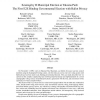Free Online Productivity Tools
i2Speak
i2Symbol
i2OCR
iTex2Img
iWeb2Print
iWeb2Shot
i2Type
iPdf2Split
iPdf2Merge
i2Bopomofo
i2Arabic
i2Style
i2Image
i2PDF
iLatex2Rtf
Sci2ools
USS
2010
2010
Scantegrity II Municipal Election at Takoma Park: The First E2E Binding Governmental Election with Ballot Privacy
On November 3, 2009, voters in Takoma Park, Maryland, cast ballots for mayor and city council members using the ScantegrityII voting system--the first time any end-to-end (e2e) voting system with ballot privacy has been used in any binding governmental election. This case-study describes how we carried out this complex engineering feat involving improved design and implementation of a novel cryptographic voting system, streamlined procedures, agreements with the City, and assessments of the experiences of voters and poll workers. The election with 1722 voters from six wards involved paper ballots with invisible-ink confirmation codes, instant-runoff voting with write-ins, early and absentee (mail-in) voting, dual-language ballots, provisional ballots, privacy sleeves, any which-way scanning with parallel conventional desk-top scanners, end-to-end verifiability based on optional web-based voter verification of votes cast, a full hand recount, thresholded authorities, three independent ...
Cryptographic Voting Systems | E2e Cryptographic Voting | Operating System | USS 2010 | Voting Systems |
| Added | 15 Feb 2011 |
| Updated | 15 Feb 2011 |
| Type | Journal |
| Year | 2010 |
| Where | USS |
| Authors | Richard Carback, David Chaum, Jeremy Clark, John Conway, Aleksander Essex, Paul S. Herrnson, Travis Mayberry, Stefan Popoveniuc, Ronald L. Rivest, Emily Shen, Alan T. Sherman, Poorvi L. Vora |
Comments (0)

